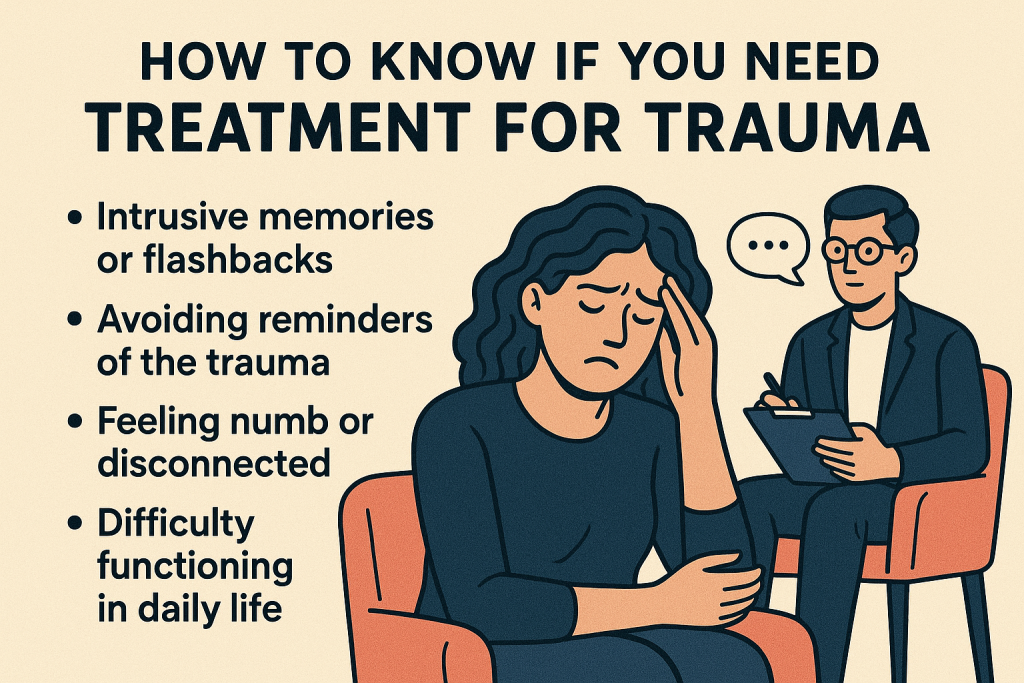Trauma can have a profound impact on an individual’s mental, emotional, and physical well-being. With the increased awareness of trauma’s effects, many are left wondering whether they need professional intervention. This blog post aims to guide you through understanding when it might be time to seek treatment for trauma, using insights from leading health organizations and current research.

Recognizing the Signs of Trauma
Trauma manifests in various ways, often disrupting daily life and relationships. Key indicators that you may need treatment include:
- Intrusive Memories and Flashbacks: Persistent and distressing memories or flashbacks related to the traumatic event can signal the need for professional help.
- Avoidance Behaviors: Steering clear of places, people, or activities that remind you of the trauma is a common symptom.
- Heightened Anxiety or Hypervigilance: Feeling constantly on edge or being easily startled can indicate an underlying issue.
- Mood Disturbances: Symptoms such as depression, irritability, or mood swings may be present.
- Difficulties in Relationships and Work: Struggling to maintain relationships or perform at work due to trauma-related issues is a significant red flag.
According to the American Psychological Association (APA) guidelines, these symptoms should be assessed based on their severity, duration, and impact on daily life APA PTSD Treatment Guidelines 2024.
The Importance of Professional Assessment
A Professional evaluation is crucial for determining the need for trauma treatment. The U.S. Department of Veterans Affairs and the Department of Defense’s Clinical Practice Guideline for PTSD recommends thorough assessments using evidence-based methods VA/DoD PTSD Clinical Practice Guideline 2024.
Structured interviews and validated screening tools help diagnose conditions like PTSD or complex trauma. The National Institute of Mental Health (NIMH) and the Centers for Disease Control and Prevention (CDC) provide valuable resources, including symptom checklists and screening tools NIMH PTSD Information and Screening CDC Trauma and Violence Prevention.
When to Seek Treatment
Research indicates that treatment is warranted when trauma symptoms persist beyond one month after the traumatic event and cause significant distress or functional impairment. The Substance Abuse and Mental Health Services Administration (SAMHSA) emphasizes that treatment is indicated when symptoms disrupt behavioral health and recovery processes SAMHSA Practical Guide for Trauma-Informed Approach.
Moreover, the International Society for Traumatic Stress Studies (ISTSS) provides guidelines to help individuals recognize when professional intervention is necessary ISTSS Resources.
Conclusion: Taking the Next Step
If you’re experiencing symptoms that interfere with your daily life, it may be time to seek professional help. Early intervention can prevent chronic mental health issues and improve overall well-being. At Luxury Rehab, we understand the complexities of trauma and are committed to connecting individuals with the right resources for their needs.
By leveraging the latest research and guidelines, we ensure that you receive comprehensive support tailored to your unique situation. For more information and assistance, do not hesitate to reach out to us.
References
- VA/DoD PTSD Clinical Practice Guideline 2024
- Research on Brief Intensive Trauma Treatment (BITT) 2025
- APA PTSD Treatment Guidelines 2024
- SAMHSA Practical Guide for Trauma-Informed Approach
- NIMH PTSD Information and Screening
- CDC Trauma and Violence Prevention
- ISTSS Resources
By understanding these signs and seeking timely professional evaluation, you can take significant steps toward recovery and improved quality of life.




